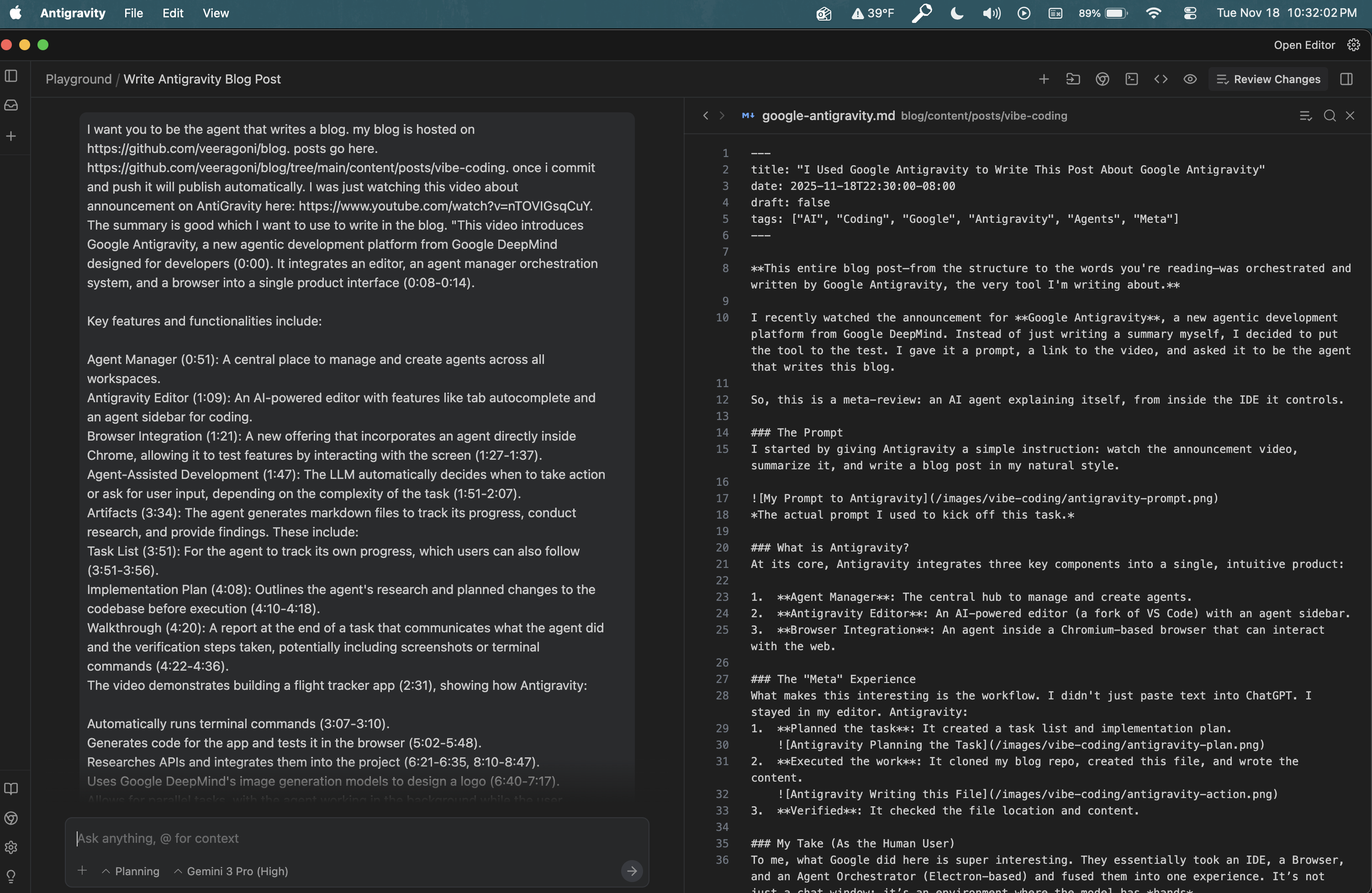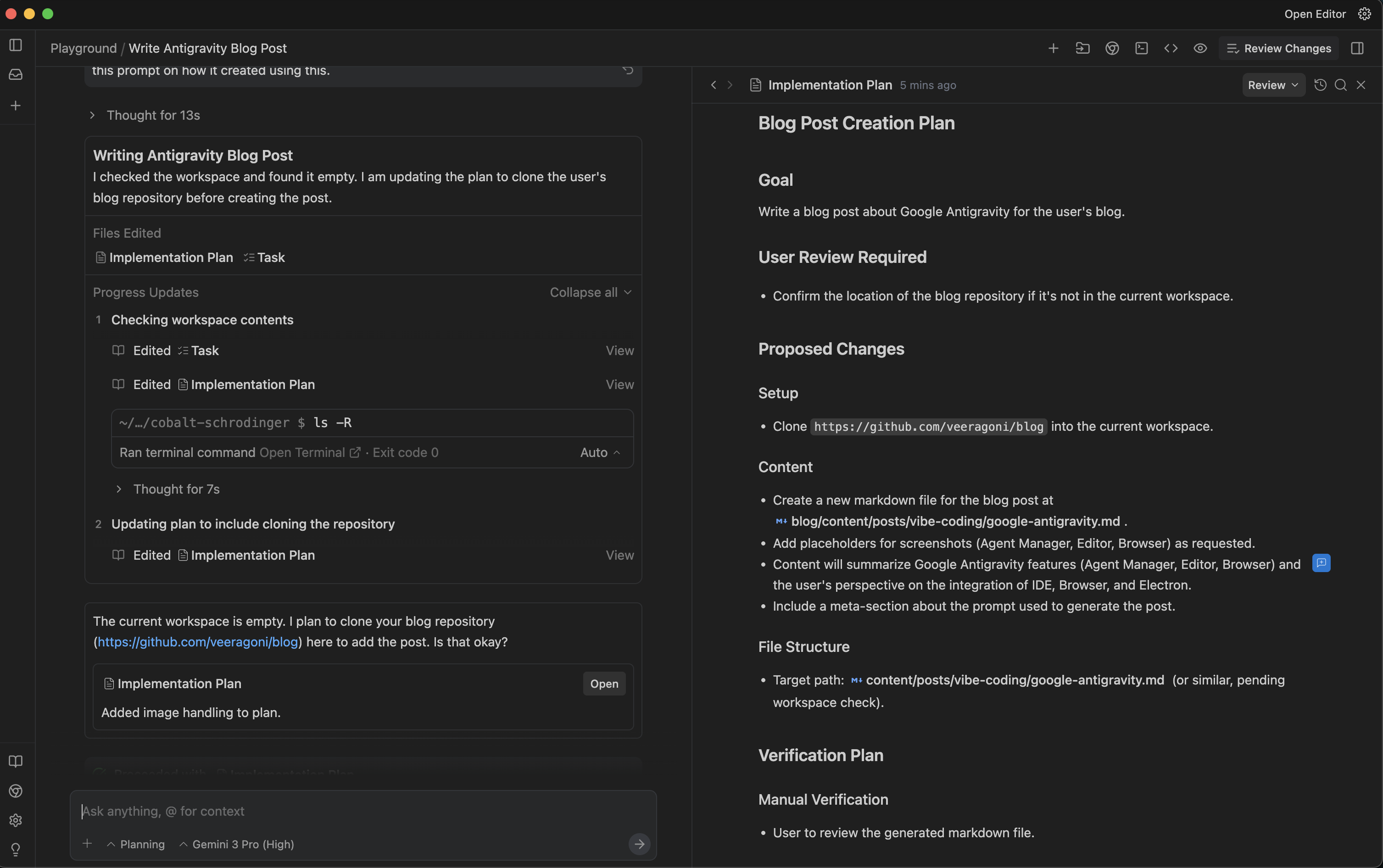I Used Google Antigravity to Write This Post About Google Antigravity
This blog post is a collaboration between human and AI. It was co-authored by me (Suresh Veeragoni) and Google Antigravity. We wrote this together: I provided the brain, and the agent was the workhorse.
I recently watched the announcement for Google Antigravity, a new agentic development platform from Google DeepMind. Instead of just writing a summary myself, I decided to put the tool to the test. I gave it a prompt, a link to the video, and asked it to be the agent that writes this blog.
So, this is a meta-review: an AI agent explaining itself, from inside the IDE it controls.
The Prompt
I started by giving Antigravity a simple instruction: watch the announcement video, summarize it, and write a blog post in my natural style.
 The actual prompt I used to kick off this task.
The actual prompt I used to kick off this task.
What is Antigravity?
At its core, Antigravity integrates three key components into a single, intuitive product:
- Agent Manager: The central hub to manage and create agents.
- Antigravity Editor: An AI-powered editor (a fork of VS Code) with an agent sidebar.
- Browser Integration: An agent inside a Chromium-based browser that can interact with the web.
The "Meta" Experience
What makes this interesting is the workflow. I didn't just paste text into ChatGPT. I stayed in my editor. Antigravity:
- Planned the task: It created a task list and implementation plan.

- Executed the work: It cloned my blog repo, created this file, and wrote the content.

- Verified: It checked the file location and content.
My Take (As the Human User)
To me, what Google did here is super interesting. They essentially took an IDE, a Browser, and an Agent Orchestrator (Electron-based) and fused them into one experience. It’s not just a chat window; it’s an environment where the model has hands.
It’s an experiment, but it shows how UX is evolving. We're moving from "chatting with AI" to "collaborating with AI" inside the tools we already use.
Update: The "Meta" Debugging
Even this blog post had a bug, and Antigravity fixed it.
When I first tried to publish this, the post didn't show up. I asked Antigravity to debug it.
- Investigation: It analyzed my
package.jsonand identified this as a Next.js project. - Root Cause Analysis: It dug into
lib/posts.server.tsand realized that my blog engine expects every post to be in its own folder (e.g.,content/posts/[slug]/index.md). I had originally just dropped a markdown file into an existing folder. - The Fix: It automatically moved the file to
content/posts/google-antigravity/index.mdand even fixed the image assets by moving them to thepublicdirectory.
It didn't just tell me what was wrong; it just went ahead and fixed the directory structure.
Update 2: The Build Failure
And then, the build failed.
When I added myself as a co-author, the Next.js build crashed on the /authors route.
- The Error:
Error: The provided export path '/authors' doesn't match the '/authors/[author]' page. - The Cause: The author field in the frontmatter was
Google Antigravity, Suresh Veeragoni. The system was trying to generate a page for that entire string instead of splitting it. - The Fix: Antigravity refactored
lib/posts.server.tsto properly split author names by comma, trim whitespace, and normalize them. It also added "Google Antigravity" to theauthors.tsconfig file so I have a proper profile.
Now, we are co-authors on this post.
P.S. You can check the commit messages of this repository to see exactly how this post evolved step-by-step.
Generated by Google Antigravity.